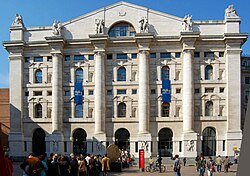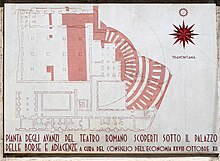
The Galleria Vittorio Emanuele II is Italy's oldest active shopping gallery and a major landmark of Milan. Housed within a four-story double arcade in the centre of town, the Galleria is named after Victor Emmanuel II, the first king of the Kingdom of Italy. It was designed in 1861 and built by architect Giuseppe Mengoni between 1865 and 1877.

Borsa Italiana, based in Milan at Mezzanotte Palace, is the Italian stock exchange. It manages and organises domestic market, regulating procedures for admission and listing of companies and intermediaries and supervising disclosures for listed companies.

Villas and palaces in Milan are used to indicate public and private buildings in Milan of particular artistic and architectural value. Milan has always been an important centre with regard to the construction of historical villas and palaces, ranging from the Romanesque to the neo-Gothic, from Baroque to Rococo.

Piazza Cordusio is a square in central Milan, Italy. The piazza takes its name from the Cors Ducis which was located on the square during Longobard times. It is well known for its several turn-of-the-19th-century Neoclassical, eclectic and Art Nouveau buildings, banks and post offices. Even though many of these have now relocated elsewhere, it is still an important commercial square in the city and hosts the Palazzo delle Assicurazioni Generali, the Palazzo del Credito Italiano and the Palazzo delle Poste, former Borsa di Milano. Piazzale Cordusio hosts the Cordusio metro station and is the starting point of the elegant pedestrian Via Dante which leads to the imposing medieval Castello Sforzesco, or Milan Castle. Opposite to Via Dante, Cordusio borders onto Piazza Mercanti, former city centre in the Middle Ages, which leads directly to Piazza del Duomo, today's city centre.

The Palazzo della Ragione is a historic building of Milan, Italy, located in Piazza Mercanti, facing the Loggia degli Osii. It was built in the 13th century and originally served as a broletto as well as a judicial seat. As it was the second broletto to be built in Milan, it is also known as the Broletto Nuovo.

Palazzo Marino is a 16th-century palace located in Piazza della Scala, in the centre of Milan, Italy. It has been Milan's city hall since 9 September 1861. It borders on Piazza San Fedele, Piazza della Scala, Via Case Rotte and Via Tommaso Marino.
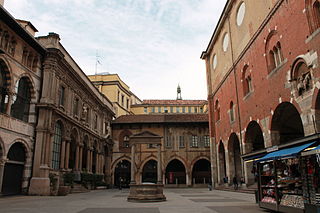
Piazza Mercanti is a central city square of Milan, Italy. It is located between Piazza del Duomo, which marks the centre of the modern city of Milan, and Piazza Cordusio, and it used to be the heart of the city in the Middle Ages. At the time, the square was larger than it is now and known as "Piazza del Broletto", after the "Broletto Nuovo", the palace that occupied the centre of the square. In the 13th century, there were six entry points to the square, each associated to a specific trade, from sword blacksmiths to hat makers.

The Giureconsulti Palace, also known as Palazzo Affari ai Giureconsulti or simply Palazzo Affari, is a 16th-century building of Milan, Italy. It is located in Piazza Mercanti, former city centre in the Middle Ages.
The following is a timeline of the history of the city of Milan, Italy.

The Palazzo Tarsis is an 18th-century mansion in Milan, northern Italy, built in the Neoclassical style. Its interiors were fully renovated after the building was bombed in 1943. Historically part of the Porta Nuova district, it is located at 1, Via San Paolo.

The following outline is provided as an overview of and topical guide to Milan:
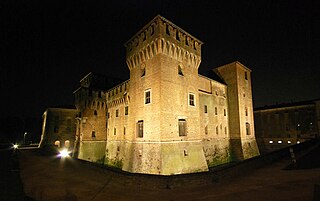
The Castello di San Giorgio is part of the Ducal palace of Mantua. It is a moated rectangular castle, each of which's four corners has a large tower and the moat is crossed by three drawbridges.

Palazzo Arese was a 16th century baroque palace and seat of a branch of the House of Arese in Milan, Italy. It was located adjacent to Casa Fontana Silvestri near the Porta Orientale. The palazzo was demolished in 1943 following damage sustained during the bombing of Milan in World War II.
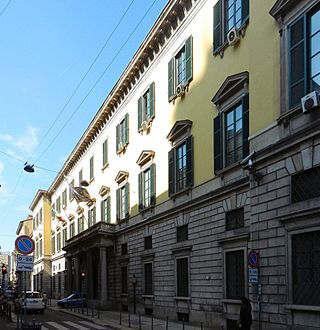
The Prefecture, Milan, also known as Palazzo Diotti, is a historic neoclassical building which has been the location of the office of the Prefect of Milan since 1859. The building is situated at 31, Corso Monforte in the city.

L.O.V.E., commonly known as Il Dito is a sculpture by Italian artist Maurizio Cattelan consisting of a hand with all the fingers severed with the exception of the middle finger. The sculpture is located in Piazza degli Affari in (Milan), where the Italian stock exchange is located. The name L.O.V.E. is the acronym of "Libertà, Odio, Vendetta, Eternità". The sculpture, built in 2010, was originally exhibited on the occasion of Cattelan's retrospective at The Royal Palace of Milan. After the exhibition closed, the city Councillor for Culture Massimiliano Finazzer Flory proposed the piece to be permanent. The business community objected to the idea but after long deliberations, facilitated by Cattelan's decision to donate the sculpture, L.O.V.E. was eventually given permanent status.

The Palazzo della Nuova Borsa Valori is a historical building in Genoa, located in Piazza De Ferrari, also known as the Palazzo della Borsa. Built by engineers Dario Carbone and Amedeo Pieragostini, its architecture recalls the Neo-16th century style, while the interiors, by Adolfo Coppedè, are inspired by the Liberty style.

Palazzo Carmagnola is a palazzo quattrocentesco in Milano, which was remodelled several times in the following centuries. Historically belonging to the Sestiere di Porta Comasina, it is located in via Rovello 2.

Palazzo Recalcati is a 16th-century palace in Milan, Italy, which was expanded during the 17th and 18th centuries. Historically situated in the district of Porta Ticinese, it is situated at Via Amedei 8.
